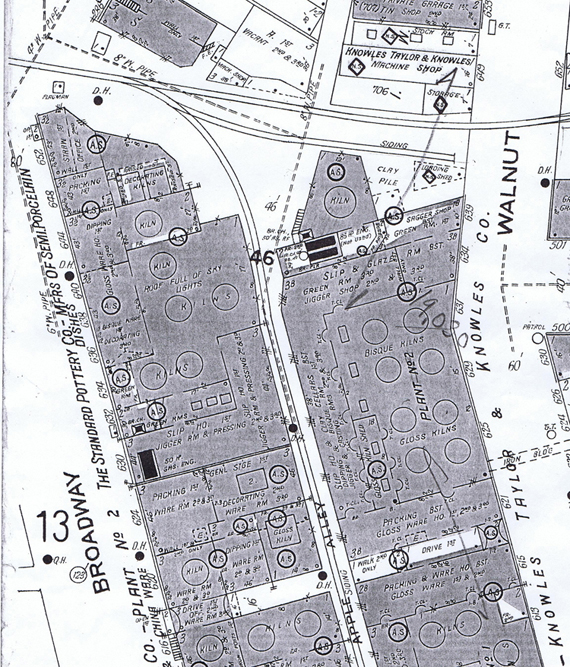
Continues connecting to the Walnut Street KT&T Pottery
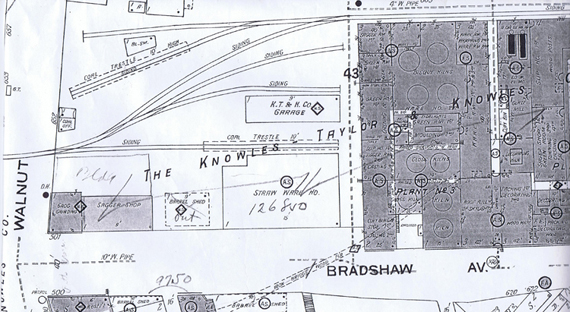
and on to the Bradshaw Ave. KT&T Pottery.
During the first six months of 1896, pottery manufacturing in East Liverpool was erratic. Potteries laid off workers and closed for long periods because of "dull trade." The only positive factor that seemed to keep them going was the possibility of William McKinley's election as President in the fall. F.W. Fowler of the Union Pottery Company stated, "We had a big batch of orders, that we had instructions to cancel in event of Bryan's election." Even the importation of English ceramics dropped considerably, it was reported, during the summer of 1894 in anticipation of McKinley's election. When it was learned that McKinley had trounced William Jennings Bryan and that he would soon be the next President, the "town went wild." East Liverpool celebrated all night with a parade, fireworks, and other jubilations. In addition to McKinley's victory, Republican R.W. Taylor, a former local attorney, also won the district congressional seat by a huge majority. Expectations were high for a dramatic improvement in local manufacturing. The Pennsylvania Railroad Company announced that because of McKinley's victory it would establish a new freight yard on the Horn Switch in anticipation of increased production by the hill potteries. The City of Hills and Kilns Life and Work in East Liverpool, Ohio William C. Gates. East Liverpool Historical Society, (1984) p. 157.
Another reason for East Liverpool's inability to attract additional industry was inadequate railroad facilities, although this situation also hampered existing industries. In 1900 the George C. Murphy Pottery Company was unable to secure railroad cars for shipments and was forced to ship an order to Texas by steamboat. W.E. Wells, general manager of the Homer Laughlin China Company, told a meeting of the Ohio Valley Improvement Association in 1902 that the present railroad facilities in East Liverpool were inadequate." He estimated that the entire pottery business of the city was curtailed by 25 percent in October because of the lack of facilities. Wells also said that the city was so hemmed in by the surrounding hills that no other railroad line could reach the city. The construction of other lines was opposed by the Pennsylvania Railroad Company which had gradually obtained control of every rail access point to East Liverpool. Wells said that projected rail lines were 'throttled" by this opposition and discouraged by the prospect of climbing or tunneling the mountains. As a result, he added, the development and expansion of plants were stymied and many new industries were forced to locate elsewhere for adequate shipping facilities.
A plan to ameliorate the situation was unveiled in April of 1903 by city officials and the Wabash Railroad Company. The company proposed to build a bridge over the Ohio River in the west end of town and to construct a line along Fifth Street to College Street then underground through Thompson's Hill to the east end in return for a right of way and an approach to the bridge. This plan would have taken the new railroad line through the center of the downtown area. The Pennsylvania Railroad Company countered by offering to construct a second track adjacent to its present one and to dispose of all the city's garbage if they were granted a right of way. By January of 1904 the Wabash Railroad plan was abandoned and fourteen pottery firms submitted a petition to city council endorsing passage of an ordinance to allow the double track to be constructed. The ordinance was passed and the new rail line was installed by 1905. Although rail facilities had been increased in East Liverpool, they remained in the control of a single company and pottery executives continued to complain about the exorbitant rates. The Pennsylvania Railroad Company had eased the problem of sufficient facilities, but had also been successful in thwarting competition. In 1904, in an effort to ease freight rates, potters wholeheartedly endorsed a plan to construct a series of dams and locks on the Ohio River to insure year-round navigation.
In December 1902 city council granted a franchise to the Youngstown and Southern Railway Company to construct a steam locomotive rail line to the city's northern limits in California Hollow. The city would not, however, grant permission to continue the tracks into the Diamond. When the company agreed to use electricity rather than steam, council acquiesced and granted the Youngstown and Ohio Railroad Company the right to connect with existing street railway lines and to operate its cars into the central city. By December 1909 the line was in operation and an interurban service was inaugurated to Salem, Ohio with a connection to the Youngstown and Southern Railroad Company in Leetonia, Ohio. By 1918 East Liverpool was connected on interurban lines with all of northeast Ohio as far as Cleveland, as well as western Pennsylvania and northern West Virginia
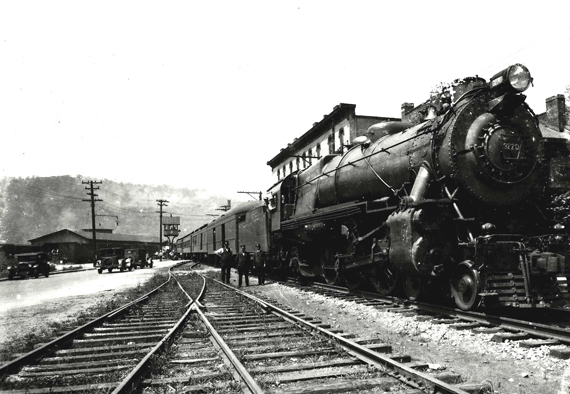
The map below identifies the picture above as to type of train, location, year,and so one.
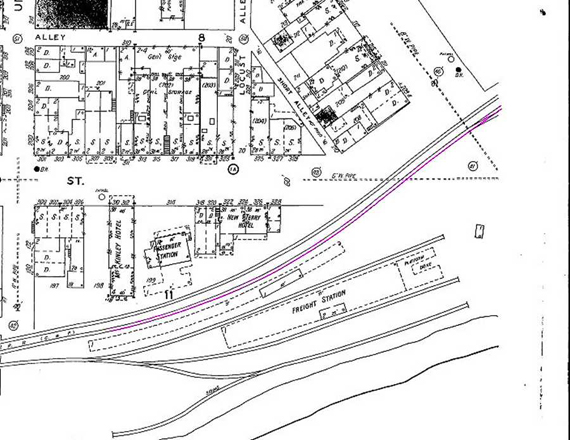
The train in the picture above is an eastbound that has made a passenger stop in downtown. Engine 3770 is a PRR type K-4 headed for Rochester and then Pittsburg. The time is the early 1930's and the photo is taken from the "River Road". The map shows the location of where the train is sitting. Map and information courtesy of Bob Lloyd.
. In 1931 the Youngstown and Ohio Railroad linking East Liverpool with Salem and connections to the northern midwest was abandoned because of a loss in business and the high cost of maintenace. In spite of efforts by the city to stop the action, the Pennsylvania Railroad Company discontinued passenger service through East Liverpool in November of 1947 after almost one hundred years. Lack of patronage in the face of the automobile and buses was cited as the reason. As late as 1940, four passenger and four freight trains stopped daily in the "Crockery City." An increase in truck transpiration and the decline in the number of industrial plants in the city also brought about the disappearance of freight trains in the city. In 1943 the "inbound" freight station at the foot of Walnut Street, built in 1860, was razed. p 347
The River And The Rails
Before we go any further we have to point out that the location of the railroad through much of East Liverpool was such that it created a very intimate relationship between the rails and the river. The rails were rather passive in this relationship, the river quite the aggressor.
We will begin a quick journey beginning at the Ohio - Pennsylvania state line and ending at the area of Patterson Field using pictures from several different floods over the years to illustrate this relationship.
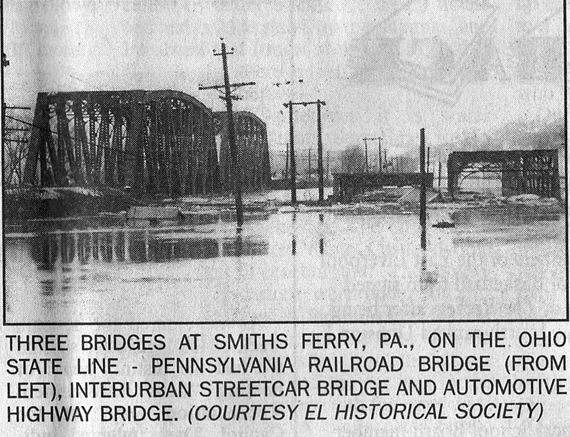
Approaching East Liverpool from the East.
Approaching the Thompson Pottery on the River Road, this train comes to a halt as water is rising along the tracks in front of it.
This water "highway" is actually covering and hiding the railroad tracks that ran between the hillside and the Thompson Pottery at the west end of the River Road.
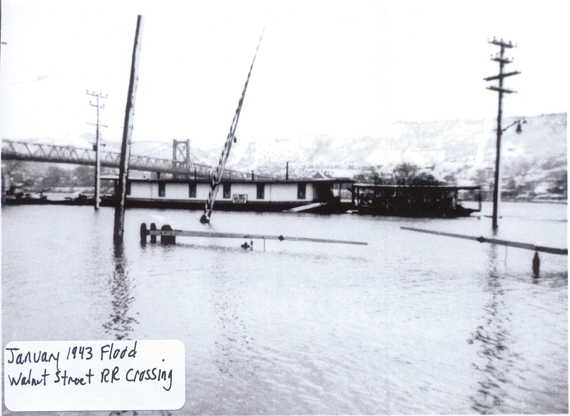
Picture courtesy of Inger Lloyd.
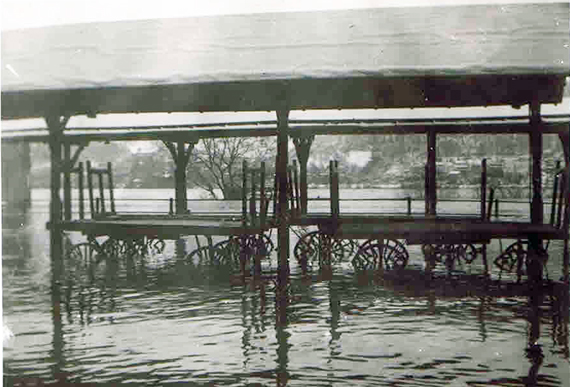
Passenger station in distress.
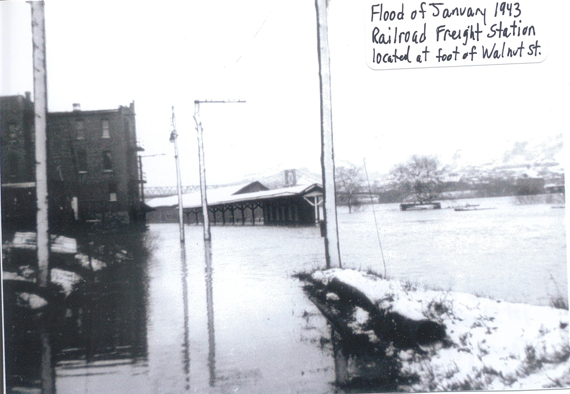
Picture courtesy of Inger Lloyd.
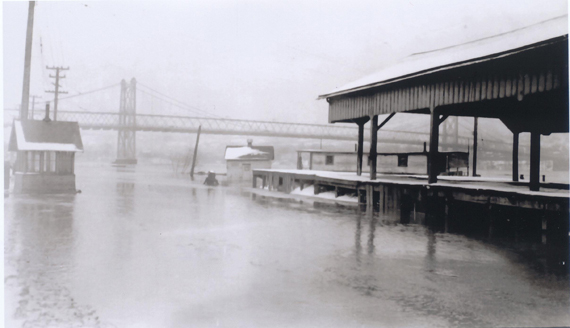
Picture courtesy of Inger Lloyd.
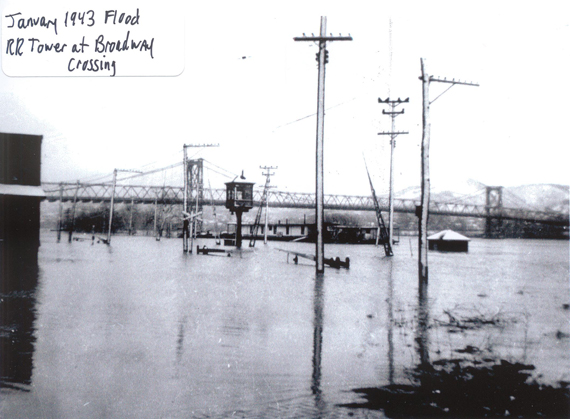
Picture courtesy of Inger Lloyd.
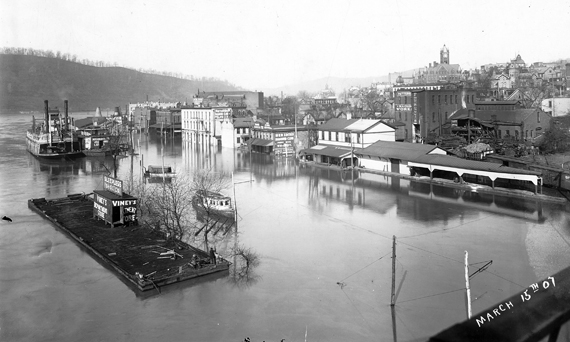
An overview of the Walnut Street and Broadway area. Note the train Station platform in the center right.
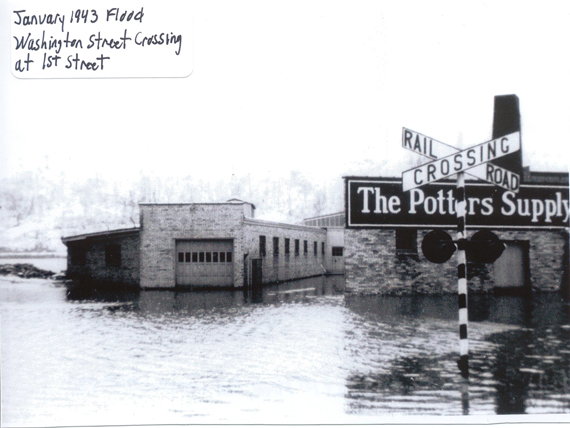
Picture courtesy of Inger Lloyd.
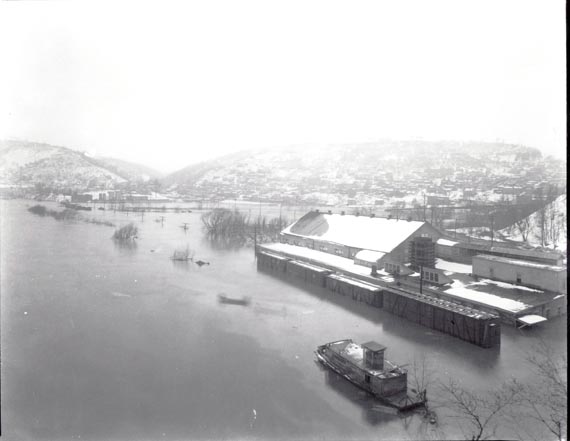
The Flint mill, 1936 flood.
The Kiln of the Glass Factory where the "Horn Switch" Spur begins. Watery times.
Same area only in drier times.
BAYARD BRANCH
"The PRR, Penn Central, and Conrail all called the railroad from Rochester, [Pa.] to Bayard,[Ohio] 'the Bayard Branch'" Courtesy of Bob Lloyd.
Click on URL below for map.
http://railsandtrails.com/TC/PRR/Cleveland/index.htm
This was the branch of the PRR that came down the river from Rochester, Pa through East Liverpool. Wellsville, etc.
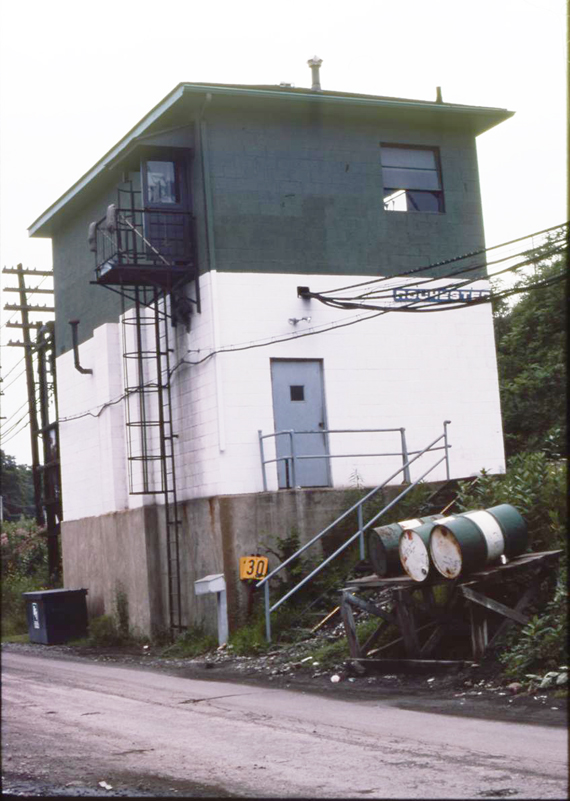
Rochester Tower, Rochester Pa. The beginning point of the Bayard Branch. Picture courtesy of Charlie Bowyer.
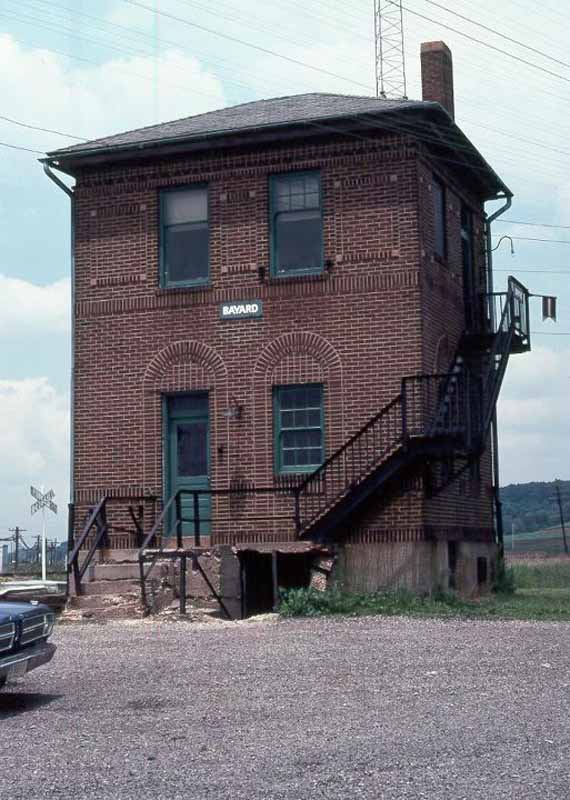
This was the interlocking tower at Bayard, (by Minerva) that controlled the Fairhope branch off the Bayard branch June, 1978. Picture and comment courtesy of Charlie Bowyer.
Railroads in and around East Liverpool 3
This site is the property of the East Liverpool Historical Society.
Regular linking, i.e. providing the URL of the East Liverpool Historical Society web site for viewers to click on and be taken to the East Liverpool Historical Society entry portal or to any specific article on the website is legally permitted.
Hyperlinking, or as it is also called framing, without permission is not permitted.
Legally speaking framing is still in a murky area of the law
though there have been court cases in which framing has been seen as violation of copyright law. Many cases that were taken to court ended up settling out-of-court with the one doing the framing agreeing to cease framing and to just use a regular link to the other site.
The East Liverpool Historical Society pays fees to keep their site online. A person framing the Society site is effectively presenting the entire East Liverpool Historical Society web site as his own site and doing it at no cost to himself, i.e. stealing the site.
The East Liverpool Historical Society reserves the right to charge such an individual a fee for the use of the Society’s material.